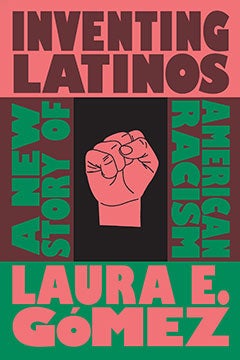Q&A: On Telling ‘A New Story of American Racism’
UCLA Law Magazine | Fall 2020 | Volume 43
 LAURA E. GÓMEZ co-founded and serves as the faculty director of the Critical Race Studies program. She first joined the UCLA Law faculty in 1994, holds the Rachel F. Moran Endowed Chair in Law and is renowned for research that focuses on the intersection of law, politics and inequality. In August 2020, she published her latest book, Inventing Latinos: A New Story of American Racism (The New Press), which has drawn wide acclaim and attention for its focus on the history of Latinos in the United States and the imprint that they have made on how race operates in the country today.
LAURA E. GÓMEZ co-founded and serves as the faculty director of the Critical Race Studies program. She first joined the UCLA Law faculty in 1994, holds the Rachel F. Moran Endowed Chair in Law and is renowned for research that focuses on the intersection of law, politics and inequality. In August 2020, she published her latest book, Inventing Latinos: A New Story of American Racism (The New Press), which has drawn wide acclaim and attention for its focus on the history of Latinos in the United States and the imprint that they have made on how race operates in the country today.
Why did you choose to write Inventing Latinos now?
There are 60 million Latinos in the United States. If we were a nation, we would have a GDP of $2.3 trillion. In short, we are the United States of America. You can’t understand the nation today — and especially where it is headed tomorrow — without understanding Latinos. Sadly, finishing this book became more urgent with the administration’s increasingly draconian policies at the southern border — policies like the separation of more than 2,000 children from their parents in 2018 and the rejection of tens of thousands of Central American asylum seekers over the past 18 months.
You write that Latinos will go from being 20 to 30 percent of the nation’s population within a few decades. What are the implications of that?
On the one hand, White nationalists have been panicking about the growing Latino population for decades. Riled up by presidential candidates like Pat Buchanan — who published a book in 2002 called The Death of the West, in which he warned of an “immigrant invasion” — they have stoked fear of immigrants and those whom they assume are immigrants. The time is now for policymakers at all levels of government to invest in K-12 schooling and all forms of higher education. Since Latinos are a disproportionately young population, they will be the backbone of the economy, both in the labor force and in terms of consumer spending. If Latinos aren’t thriving, the United States will not be thriving.
 Inventing Latinos arrives during a moment of intense activism against police violence and systemic racism. The focus has largely been on African Americans. Where do Latinos fit in the current conversation?
Inventing Latinos arrives during a moment of intense activism against police violence and systemic racism. The focus has largely been on African Americans. Where do Latinos fit in the current conversation?
I am certainly thinking about where Latinos enter the conversation. At the same time, I don’t want to take the spotlight away from the causes of and fight against anti-Black racism. Well before Summer 2020, Black Lives Matter and related movements had been working to draw attention to these issues for years, often at great personal risk to movement leaders.
In thinking about where Latinos fit in this awakening, we should first understand that Afro-Latinos are a substantial segment of the larger group, so talking about Blacks “and” Latinos obscures that fact. And yet the 400-year history of colonialism and slavery in the Americas produced a racial hierarchy in which African ancestry was downplayed and denied. Research on colorism among Latinos finds that those who are darker skinned face greater discrimination than their lighter skinned counterparts in every aspect of life, from interactions with police to educational attainment to wealth accumulation. In that respect, we Latinos are obligated to fight that anti-Black racism within our community and with respect to African Americans.
A second point, however, is that because of Spain’s colonization of Indigenous peoples of the Americas and enslavement of African laborers, Latinos are a mestizo (racially mixed) population. In complicated ways, Latinos’ European ancestry has permitted Mexican Americans (who are 70 percent of Latinos and who have been continuously present in the U.S. since the 1840s) and Puerto Ricans (who are 10 percent of Latinos and who have been continuously present in the U.S. since 1898) has allowed them to escape the most insidious forms of American racism by strategically asserting “whiteness” under the law in certain historical moments. As a result, Latinos have been situated and situated themselves as a buffer group between Whites above them and Blacks below them. These are some of the complexities Inventing Latinos explores.
You have a chapter on the history the census, race and Latinos. What were some of the controversies with the 2020 census?
That’s an important question and, unfortunately, those very controversies may result in a significant undercount of Latinos. As you know, the Constitution mandates the federal government conduct the census once a decade for reapportionment of congressional districts, but, over time, the census has also become the basis for the distribution of billions in federal funding.
So there were two major issues with respect to the 2020 census. Beginning in 1980, the census first sought to count Asian Americans and Latinos. Asian Americans were added to the race question, but Latinos were counted via the so-called Hispanic ethnicity question under the theory that “Hispanics can be of any race.” Whereas non-Latinos easily find themselves in the race options (which since 2000 have allowed for selection of two or more selections), around 40 percent of Latinos are routinely flummoxed by the options and instead select “other race,” and this has been the case for the past four censuses, 1980-2010. After years of researching the issue, census officials in 2019 proposed eliminating the Hispanic ethnicity question and instead adding a Latino/Hispanic race option. The Trump administration rejected the change, and, as a result, the 2020 census will likely show the nation’s second largest racial group is “other,” after whites.
Only weeks after Commerce Secretary Wilbur Ross declined to make that change, he proposed adding a question regarding citizenship to the 2020 census in order to “enforce” the Voting Rights Act. In summer 2019, by a 5-4 vote, the Supreme Court blocked the addition of the question, which hadn’t appeared on the census for six decades. It’s clear to me that the administration wanted to depress Latinos’ participation in census 2020, either because an estimated 5 million Latino immigrants would have feared government reprisal or because the 17 million Americans in mixed legal status families would not have risked filling out the sentence.
I’m sorry to predict there are probably still going to be Latino households who — because of the citizenship question controversy, forego participation in the census.